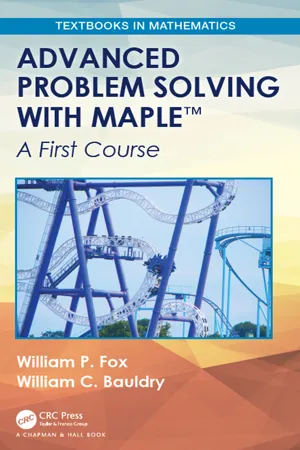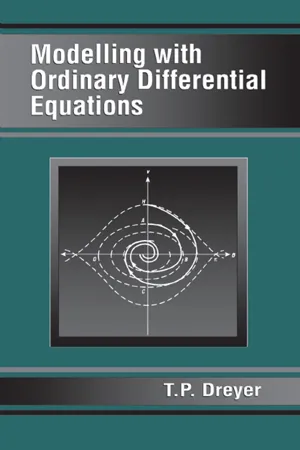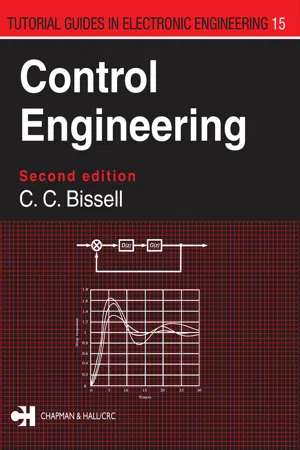Mathematics
Modelling with First-order Differential Equations
Modelling with first-order differential equations involves using mathematical equations to represent and analyze real-world phenomena that change continuously over time. These equations capture the rate of change of a quantity with respect to another, allowing for predictions and understanding of various natural and artificial processes. The solutions to these equations provide valuable insights into the behavior of dynamic systems.
Written by Perlego with AI-assistance
Related key terms
Related key terms
1 of 4
Related key terms
1 of 3
8 Key excerpts on "Modelling with First-order Differential Equations"
- eBook - ePub
Mathematical Modeling
Branching Beyond Calculus
- Crista Arangala, Nicolas S. Luke, Karen A. Yokley(Authors)
- 2018(Publication Date)
- Chapman and Hall/CRC(Publisher)
4Modeling with Differential Equations
Goals and Expectations
The following chapter is written toward students who have completed an introductory differential equations course. However, examples within the chapter have been written to include guidance for solving differential equations with computer software. Because of the potential use of technology to solve differential equations, the chapter could also be used by students who have not yet completed a differential equations course, but are somewhat familiar with computational software. Note that the Mathematica commands and MATLAB code presented are intended solely as examples, and not as instructional components for the respective software.Goals:- Section 4.1 (Introduction and Terminology): To introduce important terminology that is used when discussing differential equation models.
- Section 4.2 (First Order Differential Equations): To construct and solve models using first order differential equations.
- Section 4.3 (Systems of First Order Differential Equations): To construct and simulate models using a system of first order differential equations.
- Section 4.4 (Second Order Differential Equations): To construct and solve models utilizing second order differential equations.
4.1 Introduction and Terminology
In calculus, we learned that the derivativeis the ratio of the differential dx to the differential dt and that this derivative represents the change in the variable x with respect to the change in the variable t . For this derivative, the variable x is the dependent variable, and the variable tdxdt - Gregory Baker(Author)
- 2016(Publication Date)
- WSPC(Publisher)
Systems of Differential Equations 55.1First-order equations
Systems of differential equations are common in science and engineering because they provide mathematical models for the motion of particles, bodies and structures through dynamics, for chemical reactions of different species, for electric circuits, and for population dynamics, to mention just a few of the important applications. They can be either linear or nonlinear equations. Systems of linear differential equations with constant coefficients are generally easy to solve because the homogeneous equation allows exponential solutions. That is not the case with nonlinear equations. There are certain tricks we can try but we have no guarantees with nonlinear equations, and they are usually solved by computer simulations based on numerical procedures.Linear and nonlinear equations are often taught separately, because they are approached differently. But there is a view that provides a global perspective on the behavior of the solutions: we can sketch the solutions without knowing their detailed behavior and even when we can determine the details as in the case of linear equations with constant coefficients, it is often more useful to capture the important behavior through the global perspective.We start by illustrating the global perspective on an important example from population dynamics. Even though this example contains only a single differential equation and really does not constitute a system, it is still possible to develop a global perspective that can be extended to systems.5.1.1Population dynamics
The simplest differential equation iswhich arises, for example, when we consider the instantaneous percentage change in the growth of bacteria, an example we consider in the very first section of this book. The quantity N(t) measures the population size, for example, the number of bacteria counted in a small container, or the number of people in the world, etc. The parameter σ- eBook - ePub
Advanced Problem Solving with Maple
A First Course
- William P. Fox, William C. Bauldry(Authors)
- 2019(Publication Date)
- Chapman and Hall/CRC(Publisher)
kv. We then would have the modelF =F p+F d+F bF =m a = my ″=− m g + k vwith the same initial conditions y(0) = h, y′(0) = 0.In this chapter, we will consider a variety of models, concepts, and techniques that give the reader some of the basic tools needed in solving and analyzing first-order differential equations. Since differential equations are used often in solving problems related to continuous change, we devote a more thorough approach in this chapter.Section 2.2 provides some models that we will solve and analyze. These models come from a variety of disciplines in science and engineering, including chemistry, physics, biology, fluids mechanics, Newtonian Mechanics, environmental engineering, and financial mathematics. Modeling techniques are discussed that help determine the necessary coefficients in the models.Section 2.3 introduces slope fields. Slope fields provided a qualitative view of solutions of first-order differential equations. Recall that we said this book discusses the modeling of change. Slope fields provide information about rates of change since they are derived from information given by the derivative.Section 2.4 covers the analytical method of solution with Maple. Existence and uniqueness are addressed from conceptual and theoretical bases. The focus is on the initial-value problem and the question as to whether or not the initial value problem has a unique solution, and whether new functions can be defined by the initial-value problem.Section 2.4 investigates the special class of ODEs called linear differential equations.Section 2.5 - eBook - ePub
- Wim van Drongelen(Author)
- 2018(Publication Date)
- Academic Press(Publisher)
Chapter 9 Differential Equations Introduction Abstract In this chapter we review ordinary differential equations (ODEs) as a tool to model dynamics. We present examples of how to formulate them based on the dynamical system that needs to be modeled, and demonstrate the mathematical techniques one can employ to solve the equation analytically. We show how to solve linear differential equations with and without a forcing term, the so-called inhomogeneous and homogeneous ODEs, respectively. To illustrate the analysis of these equations, ODEs with first-order derivatives (e.g., d c / d t) and second-order derivatives (e.g., d 2 c / d t 2) are used in the examples. Next, we show how higher-order ODEs can be represented as a set of first-order ones, and how this leads to a formalism in matrix/vector notation that can be efficiently analyzed using techniques from linear algebra. To complete the overview of the available tools for solving ODEs, the final part of this chapter briefly refers to application of Laplace and Fourier transforms (see also Chapter 12) to solve them. Keywords Characteristic equation; Dynamics; Eigenvalue; Forcing term; Linear homogeneous equation; Linear inhomogeneous equation; Ordinary differential equation (ODE) 9.1. Modeling Dynamics When modeling some aspect of a neural system, we can represent static variables with algebraic expressions, e.g., the concentration c of some chemical in the brain is 10 units, c = 10. Of course, we can make these expressions a bit more complicated; for instance, the concentration could also depend on some combination of other substances a 1 and a 2 : e.g., c = 5 a 1 + a 2 + 10. It is important to realize that the variables do not change with time or space. For that reason the value of this type of equation is limited to situations where we study properties that remain constant over the range and duration of our interest - eBook - ePub
- William P. Fox, Robert E. Burks(Authors)
- 2021(Publication Date)
- Chapman and Hall/CRC(Publisher)
A fraction k would now become infected. There are many refinements to the above model. For example, we can consider that a segment of the populations is not susceptible to the disease, that the infection period is limited, that infected students are removed from the dorm to prevent interaction with uninfected students, and so forth. d i d t = k i (400 − i), k > 0 3.1.2 Some Classical First-Order Models in Differential Equations Decay: d Q d t = − k Q, k > 0 Growth: d Q d t = k Q, k > 0 Newton’s Law of Cooling: d T d t = k (T − T 0), k > 0 Chemical Mixtures, Drug Dissemination,. Dialysis: d A d t = R i n − R o u t L-R Series Circuit: L d I d t + R i = E (t) Falling Bodies, Newton’s Law of Σ Forces = 0 m d v d t = F w e i g h t + F r e s i s t a n c e = m g − k v, k > 0 Chemical. Reactions: d X d t = k (α − X) (β − X)... Spread of a Disease or Rumor: d N d t = k N (L − N), k > 0, L > 0 Filling a Tank: Tank with cross-sectional area A, filled from the top at rate K, while draining from the bottom through an orifice of area α, with height of the tank h : d h d t = (k − α a 2 g h) A 3.2 Slope Fields and Qualitative Assessments of Autonomous First-Order ODE We have used the modeling process to create a number of models that are important to differential equations. However,. sometimes we can predict outcomes of models graphically without actually solving them. This is true when we are looking for behavior rather than specific values. For example, will a specific population survive is a question that can be answered graphically. In calculus, we used derivative information to analyze a function or just to gain more information. Knowing where a function is increasing or decreasing, locations of extrema, concavity, and so forth can be important information. Interpreting the derivative as the slope of the line tangent to the graph of the function is useful in gaining information about the solution to the differential equation - eBook - ePub
Modeling Change and Uncertainty
Machine Learning and Other Techniques
- William P. Fox, Robert E. Burks(Authors)
- 2022(Publication Date)
- Chapman and Hall/CRC(Publisher)
5 Differential Equations DOI: 10.1201/9781003298762-5 OBJECTIVES Understand the typical models of ordinary differential equations. Understand the analytical solution techniques for separable and linear ODEs. Know the numerical methods. Understand the importance of slope fields. Understand the concept of correlation and linearity. Build and interpret nonlinear regression models. Build and interpret logistics regression models. Build and interpret Poisson regression models. 5.1 Introduction In this section, we introduce many mathematical models from a variety of disciplines. Our emphasis in this section is building the mathematical model, or expression, that will be solved later in the chapter. Recall previously that we discussed the modeling process. In this section, we will confine ourselves to the first three steps of the modeling process: (1) Identifying the problem, (2) Assumptions and Variables, and (3) Building the model. Example 5.1: Competition between Species Imagine a small fishpond supporting both trout and bass. Let T(t) denote the population of trout at time t and B(t) denote the population of bass at time t. We want to know if both can coexist in the pond. Although population growth depends on many factors, we will limit ourselves to basic isolated growth and the interaction with the other competing species for the scarce life-support resources. We assume that the species grow in isolation. The level of the population of the trout or the bass, B(t) and T(t), depend on many variables such as their initial numbers, the amount of competition, the existence of predators, their individual species birth and death rates, and so forth. In isolation we assume the following proportionality models (following the same arguments as the basic populations models that we have discussed before) to be true where the environment can support an unlimited number of trout and/or bass - eBook - ePub
- T.P. Dreyer(Author)
- 2017(Publication Date)
- CRC Press(Publisher)
2 First Order Differential Equations 2.1 Introduction In this chapter we shall look at mathematical models in which a first order differential equation plays a role. The equation shall always be in normal form d y d x = F (x, y) (2.1.1) If the function F is linear in y, F (x, y) = p (x) y + q (x) (2.1.2) where p and q are functions of x only, we say that the differential equation (2.1.1) is linear; otherwise it is nonlinear. The property of linearity plays an important role in the analysis of a differential equation. For example, if (2.1.1) is linear and y = f (x) satisfies the equation, d y d x + p (x) y = 0 (2.1.3) then y = cf (x) where c is an arbitrary constant, also satisfies (2.1.3) because d d x (c f (x)) = c d f d x = c [ − p (x) f (x) ] = − p (x) [ c f (x) ] For the linear differential. equation d y d x + p (x) y = q (x) (2.1.4) we call cf (x) the complementary function, and any function g (x) which satisfies (2.1.4) a particular integral. Note that y = c f (x) + g (x) (2.1.5) satisfies (2.1.4) for an arbitrary constant c. It was shown in §1.3 that different boundary values correspond to different solution curves in the (x, y)-plane. Given the boundary value y (0) = α (2.1.6) we can now match the constant in (2.1.5) to this boundary value by substitution: α = c f (0) + g (0). Hence the value of c can be found, provided that f (0) ≠ 0. Should f (0) = 0, there would exist a solution for only one boundary value, namely α = g (0). However, we shall show below that f (0) ≠ 0 so that a solution exists for any prescribed boundary value α. In general, a solution of (2.1.1) and (2.1.6) may not exist. For example d y d x = − y y 2 − 4, y (0) = 1 (2.1.7) has no solution, because the slope is only defined when | y | ≥ 2, and the boundary value requires that y = 1. It was also shown in Exercise 5 of §1.5 that there could be more than one solution - eBook - ePub
- Chris Bissell(Author)
- 2017(Publication Date)
- Routledge(Publisher)
Control engineers tend to rely on a comparatively small number of standard models which have proved to be particularly useful idealizations of features commonly encountered in dynamic systems. Such standard models can be thought of as offering the designer a ‘library’ of mathematical tools. The art of mathematical modelling is very often that of choosing and combining appropriate standard models in the light of the system specification and the designer’s experience. Sometimes the modelling will call for the analysis of the behaviour of individual system components, using a knowledge of the laws of physics, for example. In other cases it may be more appropriate to carry out experimental tests before selecting a standard model with appropriate characteristics. In practice, both analysis and experiment are often necessary.One important advantage of using standard models is that they make it easier to carry over experience with one system to others with similar dynamic characteristics. Control engineers are called upon to model a wide range of physical systems – from entire chemical plant to computer disk drives. The fact that a common approach can be adopted to control system design in such apparently widely different circumstances owes much to the use of standard models of the type described in this chapter.Deriving a mathematical model of a plant can be the most time-consuming part of a control system design, and an appreciation of what approximations are appropriate in particular circumstances comes only with practice. The examples presented in the following sections have been chosen to illustrate various features of the modelling process. Taken together, they also form a standard ‘library’ applicable to a wide range of physical systems. The ability to manipulate and interpret such standard models is of fundamental importance in control engineering.A first-order differential equation model
One type of model commonly used by control engineers takes the form of a differential equation relating system input and output. Including derivatives with respect to time in the model brings in the required dynamic information – that is, information about the way the system variables change with time. As a first example, let us return to the motor speed control system of Chapter 1 , but this time we shall assume that both input voltage v and output speed Q can vary generally with time, leading to the block diagram of Fig. 3.1
Index pages curate the most relevant extracts from our library of academic textbooks. They’ve been created using an in-house natural language model (NLM), each adding context and meaning to key research topics.
Explore more topic indexes
Explore more topic indexes
1 of 6
Explore more topic indexes
1 of 4







